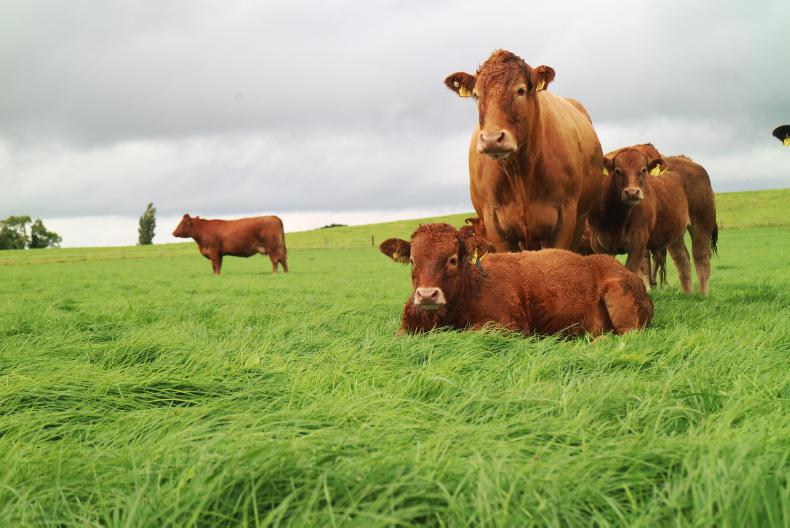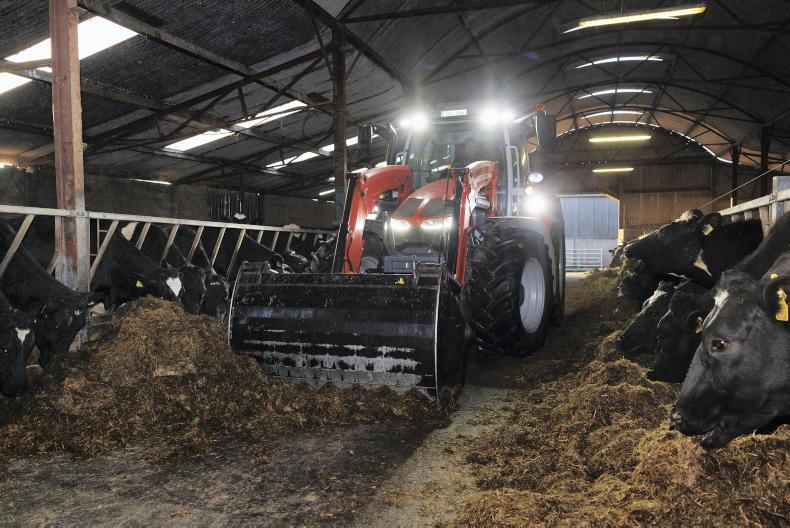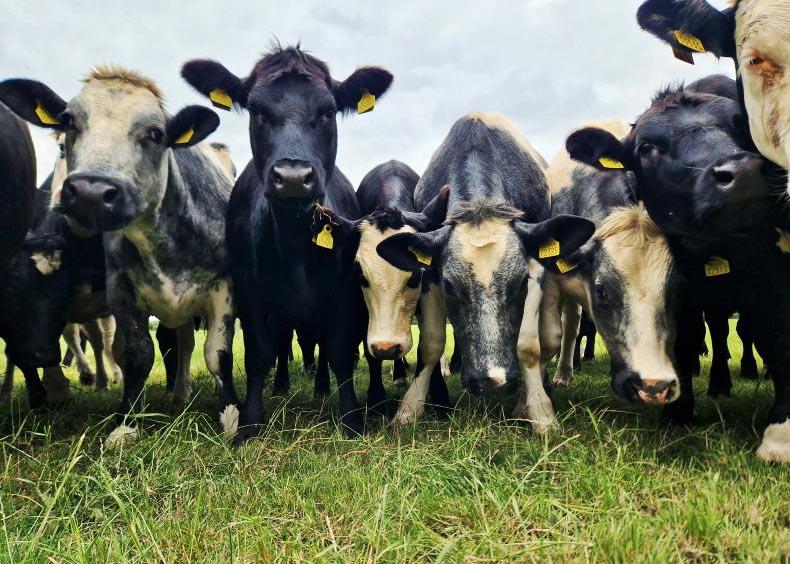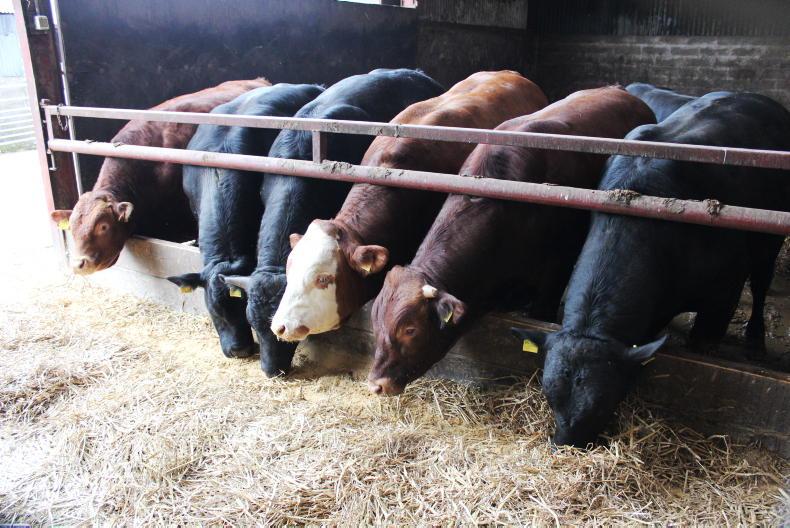Heinz Eggert manages the Sheplands farm near Sallins in Kildare. The land is laid out in two blocks, split by a main road. Ground is generally good, but mixed in terms of workability during wet periods.
The farm comprises 77ha, laid out as 48 grazing divisions. Heinz calved 113 animals (95 cows, 18 heifers) this year, in 10 weeks from early February.
He is a passionate Limousin man and tends toward the breed as his cow of choice.
“Picking a breed is like picking a tractor – you just have to go with one. They all have their pros and cons. I like the Limousin and he ticks a lot of the boxes, but I’m also aware of their limitations. Like with all continental breeds, milk isn’t fantastic,” he said.
To counter this, Heinz runs 40 half-bred Limousin (Limousin X Friesian) cows in the herd and tries to take his replacements from these.
Two Limousin bulls work the cow herd and a recently purchased Hereford serves Heinz’s heifers and late-calvers.
“They’re late for a reason. I don’t want replacements from these cows and the Hereford trims their gestation to pull them back slightly.
Cows and breeding
Heinz’s Limousin bulls boast impressive figures – with both holding five stars on the maternal and terminal indexes. One was bred on the farm and is by Castleview Virulent (CVV), from a Ronick Hawk (RKH) cow. He has a replacement value of €122, is easy calving (5.8% - 80% reliability) and produces milky daughters (as beef breeds go). Heinz sees this bull as his cow machine.
The other bull is a by Sympa (SYP) and though he is assigned five maternal stars, Heinz prefers bringing his progeny to beef.
“I am lucky that both bulls are strong terminally, but the home-bred (CVV-sired) fellow has given me better heifers in the past. His daughters from the Limousin X Friesian cows are top-class sucklers in my opinion.”
Heinz operates a strict culling policy. There are ten cows to go after weaning this year, for reasons including fertility-slippage, lameness and poor temperament.
“I love my cows – they’re my passion. But we are in a business. We have a calving interval of 371 days and 0.96 calves per cow annually. You don’t get these figures by giving lots of second chances. I’m calving over 100 cows more or less alone. I need cows that are easily handled too. The half-breds are great in this regard. I’ll admit that it’s easy to replace my cows given their culling value and the fact that heifers calve at 24 months here, without any issue.
Bull system
Heinz produces an 18-month bull and when I visited, he had just run the spring 2015 group over the weighing scales. The first batch was due for slaughter the following day.
“We weighed all 45 bulls this morning and since the 12 July (61 days) they have gained over 1.7kg daily. The bulls for slaughter tomorrow were picked based on visual fat cover and of course weight – they came in at 733kg.
The bull system of choice is similar to Teagasc Grange’s blueprint from the beginning of the decade. Spring-born calves are weaned on to a winter store diet (>70% DMD + 2kg concentrate), with a target growth rate of 0.5-0.8kg daily for the housed period.
Heinz turned this year’s bulls out on 14 March and they grazed for three months until housing on the 12 June. Once indoors, they build up gradually to an ad-lib finishing nut (14% crude protein, €230/t delivered). Heinz ensures that the bulls have access to straw and haylage at all times.
“The weight gain that these bulls achieve on spring grass is what makes this system tick. Many shy away from grazing bulls, but with a strong fence and a plentiful supply of grass there aren’t any issues. In fact, they’re coming into the shed at the very age when they begin to get really bullish.
Great grass
Heinz measures the farm weekly with a plate meter.
“Grass management has been a revelation for the farm. We’ve made huge strides since the start of the programme and grassland has been the cornerstone. In 2015, we grew 13.5 tonnes of dry matter per hectare on average. On some of the south-facing fields, we hit 15 tonnes. All of the paddocks grew over 10 tonnes and I’m working on soil nutrients to improve the lower performers. I like to get pH (lime), phosphorus (P) and potassium (K) to optimum levels before I think about reseeding.
Heinz has 80 extra bales in the yard this summer, removed as surplus from his grazing area. These bales will make an ideal feed for his weanlings, finishing heifers or thin/first-calved cows. Effective grassland management works in great synergy with a silage-based winter feeding system.
“I will begin closing up the fields around the yard on 1 October. These are the ones I will hit first in the springtime. There will be grass coming again on them by the time I go to house, but it’ll be worth much more to me in the spring. In a decent year, we close our last paddock up (house) in the last week of November.
Past, present and future
In 2008, I had 67 sucklers and I was selling store bulls and fattening my heifers. Now, on the same farm, I am calving over 110 cows and finishing everything. Our gross margin has gone from €4/ha to €777/ha.
“I am disappointed that we didn’t hit the target of €1,000, but there are shackles on us in that the housing is all straw-bedded. I spend €70 per cow on bedding annually. I am also coming out of a lease on a small amount of rented ground at the farm’s periphery this year, and am confident that I can carry current numbers on what remains.
“This will lift us up to €850/ha to €900/ha and hopefully we can push on from there. My current stocking rate is 2.02 LU/ha but the farm can do more. I’d like to settle around 2.4 LU/ha.”
113 sucklers calved in 2015.Limousin breed preferred.Males brought to bull beef @ 18 months.Non-replacement heifers @ 20 months.Farm grew 13.5t grass DM/ha in 2015.High straw costs – €70/cow (bedding alone).
Heinz Eggert manages the Sheplands farm near Sallins in Kildare. The land is laid out in two blocks, split by a main road. Ground is generally good, but mixed in terms of workability during wet periods.
The farm comprises 77ha, laid out as 48 grazing divisions. Heinz calved 113 animals (95 cows, 18 heifers) this year, in 10 weeks from early February.
He is a passionate Limousin man and tends toward the breed as his cow of choice.
“Picking a breed is like picking a tractor – you just have to go with one. They all have their pros and cons. I like the Limousin and he ticks a lot of the boxes, but I’m also aware of their limitations. Like with all continental breeds, milk isn’t fantastic,” he said.
To counter this, Heinz runs 40 half-bred Limousin (Limousin X Friesian) cows in the herd and tries to take his replacements from these.
Two Limousin bulls work the cow herd and a recently purchased Hereford serves Heinz’s heifers and late-calvers.
“They’re late for a reason. I don’t want replacements from these cows and the Hereford trims their gestation to pull them back slightly.
Cows and breeding
Heinz’s Limousin bulls boast impressive figures – with both holding five stars on the maternal and terminal indexes. One was bred on the farm and is by Castleview Virulent (CVV), from a Ronick Hawk (RKH) cow. He has a replacement value of €122, is easy calving (5.8% - 80% reliability) and produces milky daughters (as beef breeds go). Heinz sees this bull as his cow machine.
The other bull is a by Sympa (SYP) and though he is assigned five maternal stars, Heinz prefers bringing his progeny to beef.
“I am lucky that both bulls are strong terminally, but the home-bred (CVV-sired) fellow has given me better heifers in the past. His daughters from the Limousin X Friesian cows are top-class sucklers in my opinion.”
Heinz operates a strict culling policy. There are ten cows to go after weaning this year, for reasons including fertility-slippage, lameness and poor temperament.
“I love my cows – they’re my passion. But we are in a business. We have a calving interval of 371 days and 0.96 calves per cow annually. You don’t get these figures by giving lots of second chances. I’m calving over 100 cows more or less alone. I need cows that are easily handled too. The half-breds are great in this regard. I’ll admit that it’s easy to replace my cows given their culling value and the fact that heifers calve at 24 months here, without any issue.
Bull system
Heinz produces an 18-month bull and when I visited, he had just run the spring 2015 group over the weighing scales. The first batch was due for slaughter the following day.
“We weighed all 45 bulls this morning and since the 12 July (61 days) they have gained over 1.7kg daily. The bulls for slaughter tomorrow were picked based on visual fat cover and of course weight – they came in at 733kg.
The bull system of choice is similar to Teagasc Grange’s blueprint from the beginning of the decade. Spring-born calves are weaned on to a winter store diet (>70% DMD + 2kg concentrate), with a target growth rate of 0.5-0.8kg daily for the housed period.
Heinz turned this year’s bulls out on 14 March and they grazed for three months until housing on the 12 June. Once indoors, they build up gradually to an ad-lib finishing nut (14% crude protein, €230/t delivered). Heinz ensures that the bulls have access to straw and haylage at all times.
“The weight gain that these bulls achieve on spring grass is what makes this system tick. Many shy away from grazing bulls, but with a strong fence and a plentiful supply of grass there aren’t any issues. In fact, they’re coming into the shed at the very age when they begin to get really bullish.
Great grass
Heinz measures the farm weekly with a plate meter.
“Grass management has been a revelation for the farm. We’ve made huge strides since the start of the programme and grassland has been the cornerstone. In 2015, we grew 13.5 tonnes of dry matter per hectare on average. On some of the south-facing fields, we hit 15 tonnes. All of the paddocks grew over 10 tonnes and I’m working on soil nutrients to improve the lower performers. I like to get pH (lime), phosphorus (P) and potassium (K) to optimum levels before I think about reseeding.
Heinz has 80 extra bales in the yard this summer, removed as surplus from his grazing area. These bales will make an ideal feed for his weanlings, finishing heifers or thin/first-calved cows. Effective grassland management works in great synergy with a silage-based winter feeding system.
“I will begin closing up the fields around the yard on 1 October. These are the ones I will hit first in the springtime. There will be grass coming again on them by the time I go to house, but it’ll be worth much more to me in the spring. In a decent year, we close our last paddock up (house) in the last week of November.
Past, present and future
In 2008, I had 67 sucklers and I was selling store bulls and fattening my heifers. Now, on the same farm, I am calving over 110 cows and finishing everything. Our gross margin has gone from €4/ha to €777/ha.
“I am disappointed that we didn’t hit the target of €1,000, but there are shackles on us in that the housing is all straw-bedded. I spend €70 per cow on bedding annually. I am also coming out of a lease on a small amount of rented ground at the farm’s periphery this year, and am confident that I can carry current numbers on what remains.
“This will lift us up to €850/ha to €900/ha and hopefully we can push on from there. My current stocking rate is 2.02 LU/ha but the farm can do more. I’d like to settle around 2.4 LU/ha.”
113 sucklers calved in 2015.Limousin breed preferred.Males brought to bull beef @ 18 months.Non-replacement heifers @ 20 months.Farm grew 13.5t grass DM/ha in 2015.High straw costs – €70/cow (bedding alone). 











SHARING OPTIONS